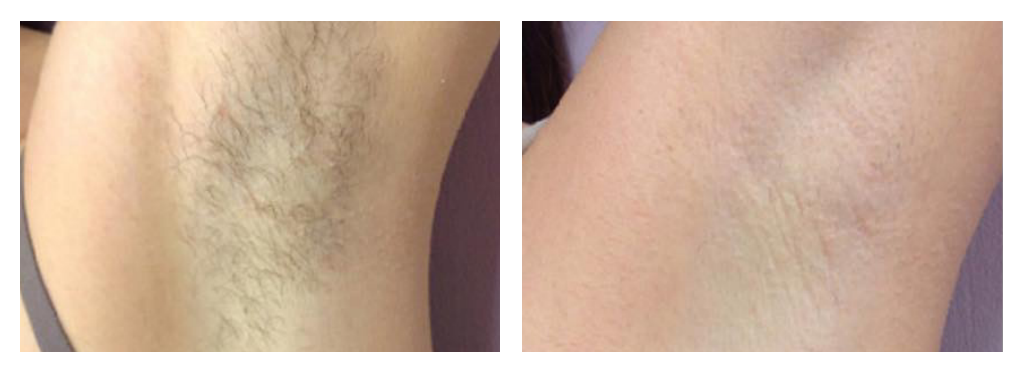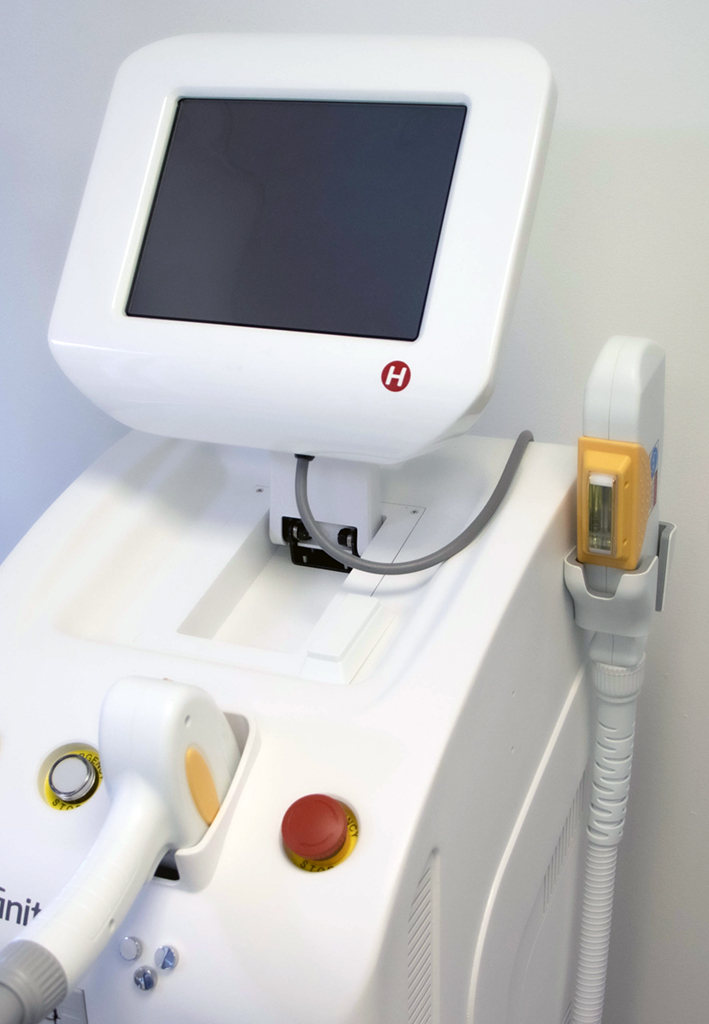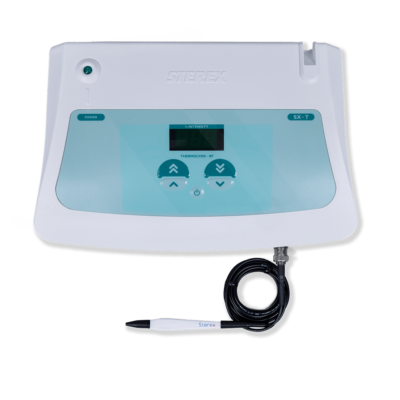Infinity DIODE Laser hair removal system
The infinity DIODE Laser hair removal system produces a beam of laser light from the application head, which is placed upon the skin. The hair structure acts as a conductor and effectively turns the laser energy into heat, raising the temperature to 70 degrees centigrade or more. The heating kills the growth cells making them incapable of producing further hair growth.
What colour hair can be treated?
Other than white, grey or red hair, all hair colours can be permanently reduced through treatments.
Does it hurt?
No anaesthesia is required and most patients describe the pain as acceptable, mainly defined as a prickle that lasts a fraction of a second.
Do I need to shave prior to treatment?
The hair should ideally be removed 1-2 days before treatment, but only by shaving or clipping. All other forms of epilation must be avoided for at least four weeks prior to treatment. Additionally, all bleaching treatments should be discontinued in the weeks leading up to the treatment.
Why do hairs grow after treatment?
The laser targets, damages and denatures the root of the hair. The hair remains in the skin. The first few weeks following treatment, the hairs will fall out as the hair cycle renews itself. During this period, it will seem that the hairs are continuing to grow.
What are the side effects?
No special precautions are needed prior to treatment, but a pair of protective glasses need to be worn throughout treatment. There are some common, mild and usually short-lived side effects of the infinity treatment. You might find that you have all, some or none of them. They may include a redness of the skin in the area that has been treated, some slight swelling and carbonisation of the hair. However, these are not always seen, and many clients have fantastic results both with and without these post treatment side effects.
How many treatments are necessary?
All the hairs on your body grow according to a hair growth cycle. The laser affects hair in 1 of 3 stages of the cycle. The number of hairs in the phase varies from 20% to 70% dependant on the area of treatment. The location of the hair also affects the speed of the growth cycle. These can vary between 6 to 24 weeks. For most clients, a treatment programme of a minimum of six treatments are sufficient to permanently reduce an area of hair growth. After the first treatment, a significant reduction in hair density could be seen, as the new hairs tend to grow back finer.
How do I prepare for treatment?
Clients should avoid all UV exposure for two weeks prior to treatment. A sun block cream with an SPF Factor of at least 30 or above must be used on the treatment area for at least four weeks after treatment. If your treatment cycles are six weeks apart, then the SPF must be worn until four weeks after your final treatment.
Is it permanent?
Most authorities would agree that using current laser technologies it is possible to permanently remove hair up to 85-90%, as repeated treatments will affect remaining Anagen stage hairs each time a treatment is delivered. Further studies have found destroyed and denatured hair follicles and cells in post treatment observations.
What is Electrolysis?
In cosmetic electrolysis, a tiny probe is inserted into the hair follicle, and a small amount of electrical current is delivered to destroy the growth centre of the hair. This process leaves the surrounding skin unharmed when performed correctly and is the only method recognised by medical professionals for delivering permanent hair removal.
The Electrolysis Procedure
A typical electrolysis treatment for hair removal involves the following steps:
- The practitioner cleans the area to be treated.
- A fine, sterile probe (needle) is inserted into the natural opening of the hair follicle. Importantly, the probe is not inserted into the skin, but along the path of the hair to reach the root.
- Once the probe is in place, the operator activates a device that sends a small amount of electrical current through the probe to the base of the follicle.
- The hair is then removed with tweezers. If the follicle has been effectively treated, the hair will slide out with little resistance.
- This process is repeated for each follicle to be treated in the session.
Session length, frequency, and the total number of treatments required depend on the area treated, the density of hair, and individual hair growth cycles. Multiple sessions are almost always necessary for optimal results.
Who is Electrolysis For?
Electrolysis is suitable for almost anyone seeking permanent hair removal, regardless of skin tone or hair colour. Unlike laser hair removal, which is most effective on individuals with light skin and dark hair, electrolysis works on all hair and skin types.
Some individuals seek electrolysis for medical or personal reasons, such as managing hirsutism (excessive hair growth) caused by hormonal imbalances or as part of gender- affirming care.
Benefits of Electrolysis
- Permanent Hair Removal
- Versatility: Effective on all hair colours and skin types, including fine, light, grey, or red hairs that do not respond to laser treatments.
- Precision: Can target small areas (like eyebrows) as well as larger zones.
- Minimal Downtime: Most people can return to their normal activities immediately after treatment.
Pain and Discomfort
Pain tolerance is subjective and depends on individual sensitivity as well as the area being treated. Some describe the sensation during electrolysis as a mild pinch, sting, or heat, while others feel little to no discomfort at all. Topical anaesthetics may be applied before treatment to reduce discomfort.
Potential Side Effects and Risks
While electrolysis is generally safe when performed by a trained and licensed professional, there are potential side effects:
- Redness and swelling in the treated area (usually temporary)
- Tingling or sensitivity
- Scabbing or slight bruising in rare cases
- Possible infection if aftercare instructions are not followed
- Hyperpigmentation or, rarely, scarring if the procedure is not performed properly
Aftercare generally involves keeping the area clean and avoiding sun exposure, heavy makeup, or harsh products for a short period after treatment.




